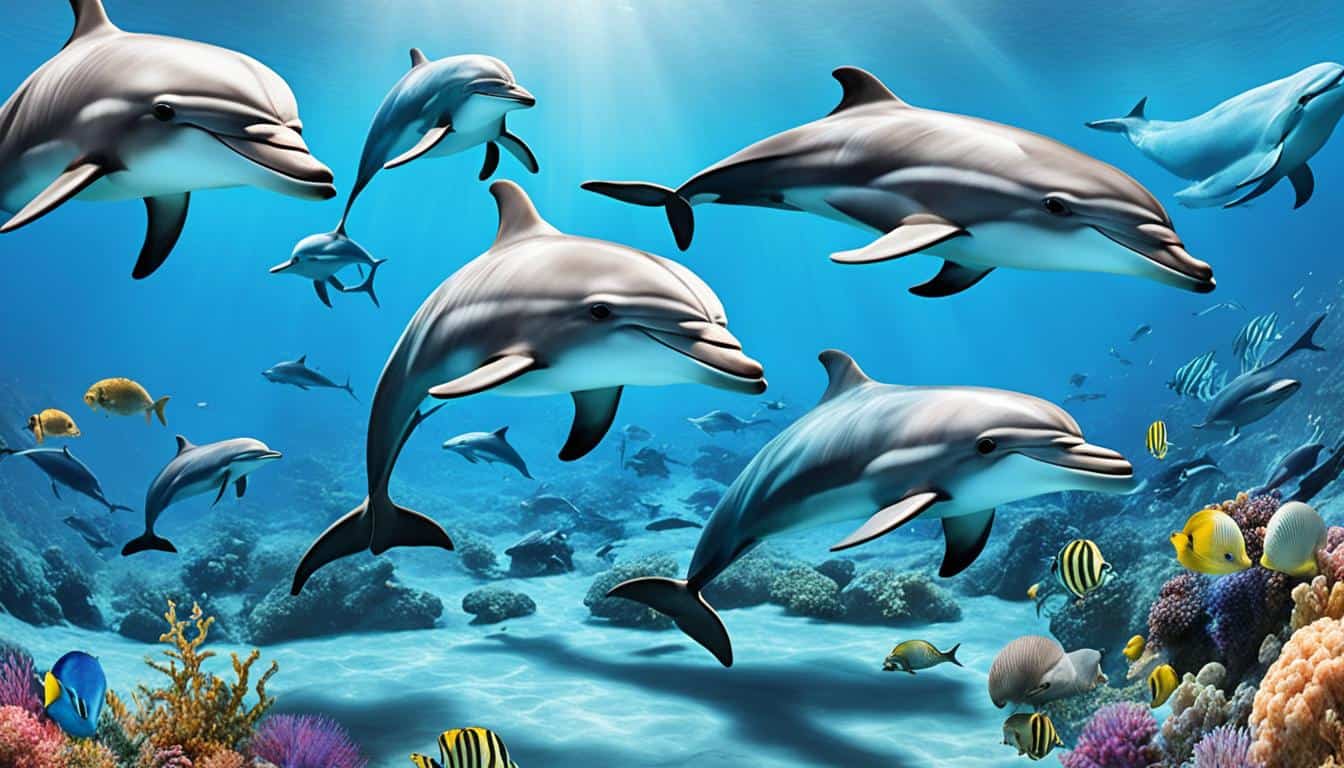Dolphins are fascinating creatures of the ocean. Many wonder, are dolphins mammals? They belong to the cetacean family, which includes whales and porpoises. Dolphins have traits that make them marine mammals.
They look like fish but are warm-blooded, breathe air, and have live births. These traits show dolphins are more like mammals than fish.
Characteristics of Mammals
Understanding what makes mammals unique helps us see how diverse they are. Dolphins, being mammals, have traits that make them stand out among sea creatures.
Warm-Blooded Nature
Dolphins keep their body temperature steady, even in cold water. This is key for surviving in chilly seas. It helps them avoid health issues common in cold-blooded animals.
Lungs for Breathing
Dolphins breathe air, not like fish with gills. They come up to the surface to take in and let out air through their blowhole. This way, they can stay active underwater and breathe efficiently.
Live Birth and Nursing
Dolphins have a special way of making babies, just like all mammals. They give birth to live young after about a year of pregnancy. The babies drink milk that’s low in lactose but high in fat, helping them grow fast. They nurse for two to four years, showing a deep bond with their mothers.
Are Dolphins Mammals?
Dolphins are definitely part of the ocean’s mammals. You might ask why they are considered mammals. Dolphins have certain traits that make them mammals.
They are warm-blooded, which means they keep their body temperature steady. This helps them live in different ocean conditions.
Dolphins need to breathe air because they are mammals. They come up to the surface to take a breath. This shows how they’ve adapted to life underwater while still needing air.
Unlike fish, dolphins breathe through lungs. This fact confirms they are mammals.
When it comes to reproduction, dolphins stand out. They give birth to live young, unlike many other sea creatures. This shows their role as mammals in the ocean.
Dolphin Species and Their Features
The world of dolphins is full of diversity. There are about 40 dolphin species, each with its own traits. They belong to the Delphinidae family, which includes oceanic dolphins. Learning about dolphin types helps us understand their unique features and how they adapt to life in the sea.
Diversity of Dolphin Species
From the tiny Maui’s dolphin to the big orca, dolphins come in many sizes and shapes. Here are a few examples:
- Maui’s Dolphin: One of the smallest dolphin species, known for its unique markings.
- Common Bottlenose Dolphin: Recognizable for its curved mouth and high intelligence.
- Killer Whale (Orca): The largest dolphin species, distinguished by its black and white coloring.
- Spinner Dolphin: Famous for its acrobatic spins out of the water.
Unique Adaptations
Dolphins have many special features that help them live in the ocean. Some of these include:
- Streamlined Bodies: Their shapes let them swim fast through the water.
- Conical Teeth: These teeth are perfect for catching fish and squid.
- Specialized Physiology: They have collapsible lungs that let them dive deep safely, avoiding the dangers of deep-sea pressure.

Dolphins come in many types, each with its own special traits. These traits show how they have evolved to live in the sea. Knowing about these differences helps us understand their behavior and their role in the ocean.
| Dolphin Species | Size | Notable Feature |
|---|---|---|
| Maui’s Dolphin | 1.2 meters | Unique facial markings |
| Common Bottlenose Dolphin | 2.5 – 3.5 meters | High intelligence and social behavior |
| Killer Whale (Orca) | 6 – 8 meters | Distinct black and white coloration |
| Spinner Dolphin | 2 – 2.5 meters | Acrobatic spinning behavior |
Dolphins and Their Habitats
Dolphins are amazing marine mammals that live in many ocean environments. They can be found in coastal waters full of life or deep in the open sea. Most dolphins like warm tropical waters, but some can even live in cold ocean areas.
Dolphins are important to their ocean homes. They live in groups called pods, which help them hunt and stay safe from danger. These groups show how smart and emotional dolphins are in the ocean.
Habitat quality is crucial for the well-being of dolphins. Sadly, they face threats like pollution and damage to their homes, often from human actions like fishing. It’s key to protect dolphins and their homes to keep these amazing creatures safe and healthy in the ocean.
The Evolutionary Journey of Dolphins
Learning about dolphins’ evolution helps us understand their life in the sea. About 49 million years ago, they moved from land to water, coming from a hippopotamus-like ancestor. This big change led to their special traits for living underwater.
Over time, dolphins adapted to life in the ocean. Fossils show how their legs turned into flippers for better swimming. Moving their nose holes to the top helped them breathe easily at the surface.
Dolphins have many amazing traits that show their evolution from land to sea. They can talk, hunt, and travel long distances in the ocean. These abilities make them key parts of the marine world. Their story teaches us about their biology and why we must protect them from harm.
FAQ
Are dolphins mammals?
Yes, dolphins are classified as mammals. They share key traits with other mammals. These traits include being warm-blooded, breathing air with lungs, and giving birth to live young.
What are some unique dolphin facts?
Dolphins are fascinating marine mammals. They show complex social behaviors and have diverse species. They communicate using sounds and can dive deep thanks to their special physiology.
How do dolphins breathe?
Dolphins breathe air using lungs, not gills. They surface often to breathe in and out through their blowhole. This lets them exchange air efficiently while living in water.
Why do dolphins give live birth?
Dolphins, like all mammals, give birth to live young. This sets them apart from fish. They nurse their calves, which is key for the young dolphins’ survival and growth.
How do dolphin species vary?
There are about 40 dolphin species, from the small Maui’s dolphin to the large orca. Each species has unique physical and behavioral traits suited to their environment.
What adaptations do dolphins have for life in the ocean?
Dolphins have streamlined bodies for fast swimming and conical teeth for catching prey. Their physiology, including collapsible lungs, lets them dive deep and adapt to different ocean conditions.
What kind of habitats do dolphins inhabit?
Dolphins live in various marine habitats, from coastal waters to deep ocean zones. Many prefer warmer tropical waters, but some can live in cooler climates too.
How have dolphins evolved over time?
Dolphins evolved from land mammals about 49 million years ago, moving to the sea. Fossils show how their bodies changed, like the growth of flippers and blowholes, making them marine mammals.







